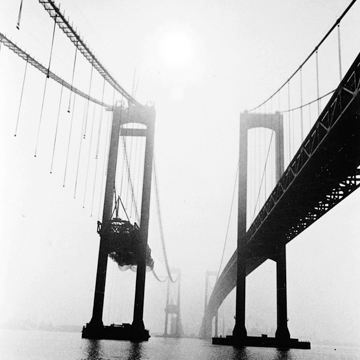Building on their enthusiasm for good roads, some Delawareans had advocated a bridge to New Jersey as early as 1917, and more seriously in 1927–1928 (a tunnel was suggested, too). The legislature approved a bond issue for a World War II memorial bridge in April 1945, and New Jersey soon agreed to participate in the project. The 2,150-foot main span of the bridge was sixth longest in the world (all the rivals being in the United States). Its design resembled Oakland (number four) and Bronx-Whitestone (number five) bridges, both about 2,300 feet in span. The steel towers, of cellular construction with riveted plates and weighing 4,000 tons each, rose 440 feet above the river and, being free from diagonal bracing, displayed breathtaking verticality. The east tower, from its base on marine clays to the top, was 559 feet, taller than the Washington Monument; 12,600 miles of twenty-inch cable were used, each composed of 8,284 wires. Including approaches, the bridge measures 3.5 miles.
By 1961, bridge traffic was 53 percent heavier than predicted a decade earlier, and plans were launched for a second span, the whole forming the longest twin span in the world. Vice President Hubert Humphrey helped dedicate the new bridge in 1968. The two spans look nearly identical, but the second rests mostly on steel piles, not the concrete bases of the first, and it is heavier, for increased rigidity (the greatest pull on any one cable being twenty-two million pounds, versus eighteen million for the first bridge). Today the Delaware Memorial Bridge is one of the state's best-known structures.


